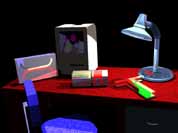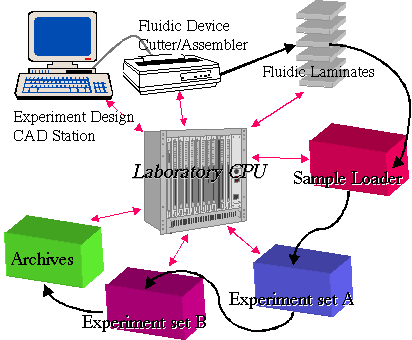
A New Microfluidic Paradigm for Biological and Biochemical Research
![]()
 |
A New Microfluidic Paradigm for Biological and Biochemical Research |
|
Biologists and chemists today are fettered by glassware-based tools that are mostly over 100 years old. These macroscopic devices include the beaker, volumetric flask, stirring hot plate, and centrifuge. Experiments are conceived as a series of discrete operations carried out by people (or robots) at separate workstations. Sample preconditioning prior to measurements is manual, slow, unique to each type of experiment, and labor intensive. Changes in experimental protocol require purchasing new equipment, manual labor and, often, re-design of the laboratory. Data acquisition requires handwriting in lab notebooks, which is slowly translated to manuscripts.
Macroscopic discrete devices (beaker, volumetric
flask, stirring hot plate, centrifuge) considered intrinsic
to the science. Experiments are conceived as a series of discrete
operations carried out by people (or robots) at separate
workstations. Sample preconditioning is manual, slow, and unique to
each type of experiment. Changes in experimental protocol require purchasing
new equipment, manual labor and, often, re-design of the
laboratory. Data acquisition requires handwriting in lab notebooks
, which is slowly translated to manuscripts.
Biology and Chemistry Today

Microfluidics--An Enabling Technology for the New Experimental Sciences. The use of microarrays has alerted the biological community that there are new ways to solve today's problems. Microfluidics enables the use of small volumes, avoids reagent and waste costs, and allows new types of assays that are not possible at macroscopic scales. Most microfluidic research has focused on single-task devices, not systems. To date most microfluidic systems have been expensive, optimized for one specific problem, and not reconfigurable. We propose to extend a new approach that has been developed for point-of-care medical diagnostic instruments to the use of microfluidics for important biological and biochemical research projects.
Schematic polymeric laminate
chemical system incorporating several interconnected
processing modules, one of which is being interrogated by
laser-induced fluorescence. It is in every way analogous to
a chemical processing plant with dimensions measured in
acres--the same rules of unit operations apply, except that
the low Reynolds numbers and high surface-to-volume ratios
constrain some processes and allow new ones to be used.
Experiments are designed to
be optimal for the small samples used, including multiple
processing steps carried out entirely within the
laminate. Optical and electrical
access for real-time analysis by standardized off-laminate
instruments are provided. If the experiment is not
optimal, redesign and retesting in one day is
straightforward. Because the laminates
themselves cost only a few dollars, if the experiment works
well, the device can be duplicated inexpensively for use at
home and shipped as a file for use by collaborators
elsewhere the next day.
![]()
|
Representative credit-card-sized 7-layer Mylar laminate. This microfluidic system fabricated by Micronics is the basis of a miniature flow cytometer that counts blood cells and measures Hb concentration. It includes anti-sedimentation coils, valves, mixers, a sheath flow cell alignment device, and waste storage, and is ~1 mm thick. Features are no smaller than ~50 µm if they are produced by a simple CO2 laser cutting system (cost ~$25K). Time from CAD file to finished devices < 4 hrs. |
|
We propose a paradigm in which rapid fabrication of a versatile laminate-based technology allows integration of multiple chemical processes for one sample on a single dedicated experimental fluidic system.
Integrate multiple chemical processes
for one sample on a single dedicated experimental fluidic
system Fluidic systems custom designed for
each experiment at CAD workstation, manufactured
overnight This low-cost system tracks all
experimental details and reports them direct to the lab
information system Fluidic system functions as a sample
storage archive

The research cycle proposed, in which the researcher designs his or her own instruments for performing complex multistep tasks. Each fluidic system is custom-designed for each experiment at a CAD workstation, manufactured in-house overnight for pennies per laminate. The laminate contains the fluid-handling components, but all electronics, optics, pumps and reservoirs remain macroscopic and attached to fluidic workstations. Through optical and electrical access to the fluids in the laminates this low-cost system can track all experimental details and report them directly to the lab information system. At the end of the experiment, the laminate fluidic system functions as a sample storage archive. The CAD software could ultimately perform the complete instrument design as can now be done for electronics circuitry.
Laminate-Based Chemistry. Experiments will be (re)designed to be optimal for the small samples used, including multiple processing steps carried out entirely within the laminate. If the experiment is not optimal, redesign and retesting in one day is straightforward--the laminates themselves cost only pennies. If the experiment works well, the whole chemical system can be duplicated inexpensively for repeated use at its point of origin and elsewhere just by transmitting the design file to colleagues across campus or across the world. This will open the first high bandwidth chemical interconnect between widely spaced laboratories for physical collaboration to solve emergent biochemical and biomedical problems.
We plan to create in CSI this new paradigm for the biological and chemical laboratory. To succeed, CSI's lab must ultimately demonstrate the flexibility to convert most common biological and chemical protocols to laminate format. Further, it must be simple enough to be rapidly and inexpensive duplicated elsewhere to demonstrate high-speed inter-laboratory collaboration.
Major challenges include conversion of the chemical/biochemical processes central to CSI to laminate-based devices, optimizing the processes, optimizing optical, fluidic, and electrical interfaces, designing versatile inexpensive external equipment that extracts data from the laminates, developing a fluidic model to allow coupling of processes in arbitrary sequences of devices into systems, integrating multiple processes on single laminates, and, with collaborators elsewhere, creating fluidic CAD software for laminate design by the biologist with no microfluidic expertise.
A successful CSI microfluidics effort promises a new glassware-free paradigm for carrying our biological and chemical research, and a research technology that is inexpensive, flexible, agile, readily portable to other laboratories, and intrinsically compatible with the information-intensive research of the post-genomics era.
|
Return to Microfluidics Home Page Return to Yager Group Home Page
|